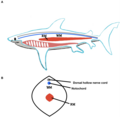Portal:Sharks
Welcome to the shark portal

Sharks are a group of elasmobranch fish characterized by a cartilaginous skeleton, five to seven gill slits on the sides of the head, and pectoral fins that are not fused to the head. Modern sharks are classified within the clade Selachimorpha (or Selachii) and are the sister group to the Batoidea (rays and kin). Some sources extend the term "shark" as an informal category including extinct members of Chondrichthyes (cartilaginous fish) with a shark-like morphology, such as hybodonts. Shark-like chondrichthyans such as Cladoselache and Doliodus first appeared in the Devonian Period (419–359 million years), though some fossilized chondrichthyan-like scales are as old as the Late Ordovician (458–444 million years ago). The oldest confirmed modern sharks (selachimorphs) are known from the Early Jurassic, about 200 million years ago, though records of true sharks may extend back as far as the Permian.
Sharks range in size from the small dwarf lanternshark (Etmopterus perryi), a deep sea species that is only 17 centimetres (6.7 in) in length, to the whale shark (Rhincodon typus), the largest fish in the world, which reaches approximately 12 metres (40 ft) in length. They are found in all seas and are common to depths up to 2,000 metres (6,600 ft). They generally do not live in freshwater, although there are a few known exceptions, such as the bull shark and the river shark, which can be found in both seawater and freshwater. Sharks have a covering of dermal denticles that protects their skin from damage and parasites in addition to improving their fluid dynamics. They have numerous sets of replaceable teeth.
Several species are apex predators, which are organisms that are at the top of their food chain. Select examples include the tiger shark, blue shark, great white shark, mako shark, thresher shark, and hammerhead shark. (Full article...)
Selected article -
Zebra sharks are nocturnal and spend most of the day resting motionless on the sea floor. At night, they actively hunt for molluscs, crustaceans, small bony fishes, and possibly sea snakes inside holes and crevices in the reef. Though solitary for most of the year, they form large seasonal aggregations. The zebra shark is oviparous: females produce several dozen large egg capsules, which she anchors to underwater structures via adhesive tendrils. Innocuous to humans and hardy in captivity, zebra sharks are popular subjects of ecotourism dives and public aquaria. The World Conservation Union has assessed this species as Vulnerable worldwide, as it is taken by commercial fisheries across most of its range (except off Australia) for meat, fins, and liver oil. There is evidence that its numbers are dwindling.
Did you know (auto-generated)

- ... that since 2018, IKEA's stuffed toy shark Blåhaj has become a popular Internet meme and an icon of the online transgender community?
- ... that Alexis Sharkey's last Instagram post before her murder documented her travels to Tulum, Mexico?
- ... that Timo Meier became the first player in San Jose Sharks franchise history to score five goals in one game when he was 25?
- ... that Hixxy and Sharkey created a schism in the UK rave music scene in 1995?
- ... that "the Hurricane Shark is real"?
- ... that the ampullae of Lorenzini enable sharks to sense electric fields?
Categories
Related portals
WikiProjects
Selected picture -

More Did you know? -
- ... that the zebra shark is striped when young and spotted when mature?
- ... that the blurred and smooth lanternsharks form a species group distinguished from the rest of their family by the shape and arrangement of their dermal denticles?
- ... that the leopard shark feeds on anchovies by swimming into their schools with its mouth open and waiting for them to accidentally enter?
- ... that relative to its body size, the horn shark has the strongest known bite of any shark?
- ... that the title for Peter Benchley's best-selling 1974 novel Jaws was not agreed until 20 minutes before it went into production?
General images
Topics
For additional lists of marine life-related featured articles and good articles see:
Wikimedia
The following Wikimedia Foundation sister projects provide more on this subject:
-
Commons
Free media repository -
Wikibooks
Free textbooks and manuals -
Wikidata
Free knowledge base -
Wikinews
Free-content news -
Wikiquote
Collection of quotations -
Wikisource
Free-content library -
Wikispecies
Directory of species -
Wikiversity
Free learning tools -
Wiktionary
Dictionary and thesaurus















































